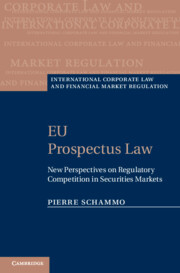Book contents
- Frontmatter
- Contents
- Preface and acknowledgements
- List of abbreviations
- Table of cases
- Table of legislation
- Introduction
- PART I Prospectus disclosure in a wider institutional context
- PART II Prospectus disclosure regulation
- PART III Prospectus disclosure enforcement
- 5 Introduction
- 6 Prospectus disclosure enforcement: strategy and arrangements
- 7 Enforcement: national implementation
- PART IV Prospectus disclosure and regulatory competition
- PART V Conclusions and suggestions for the future
- Select bibliography
- Index
5 - Introduction
from PART III - Prospectus disclosure enforcement
Published online by Cambridge University Press: 01 June 2011
- Frontmatter
- Contents
- Preface and acknowledgements
- List of abbreviations
- Table of cases
- Table of legislation
- Introduction
- PART I Prospectus disclosure in a wider institutional context
- PART II Prospectus disclosure regulation
- PART III Prospectus disclosure enforcement
- 5 Introduction
- 6 Prospectus disclosure enforcement: strategy and arrangements
- 7 Enforcement: national implementation
- PART IV Prospectus disclosure and regulatory competition
- PART V Conclusions and suggestions for the future
- Select bibliography
- Index
Summary
Part II examined prospectus disclosure regulation. Part III deals with prospectus disclosure enforcement. This chapter introduces the subject matter and presents the issues that will be discussed in the next chapters.
From an enforcement perspective, the problem with disclosure regulation can be described as follows. If we examine specific disclosure items, as they are found in the Level 2 PR, it is possible to make a rough distinction between (i) information items that essentially require issuers to provide standardised information and that, therefore, leave issuers comparatively little discretion, and (ii) items which require issuers to provide a description of their business or situation in more general terms (e.g., ‘research and development’, ‘risk factors’ or ‘trend information’). As far as this second type of items is concerned, issuers are, at the outset, left with a good deal of discretion. They may decide to ‘gloss over’ material facts. Of course, they may also simply ‘lie outright’ with respect to any type of disclosure item. Hence, the point is that even under a mandatory disclosure regime, the quality of disclosure – e.g., the truthfulness and completeness of the information – may still vary significantly.
Strategies In order to deal with quality problems, a number of strategies can be envisaged. It is useful to differentiate between ex ante and ex post strategies. Licensing and certification are both ex ante strategies.
- Type
- Chapter
- Information
- EU Prospectus LawNew Perspectives on Regulatory Competition in Securities Markets, pp. 193 - 199Publisher: Cambridge University PressPrint publication year: 2011

